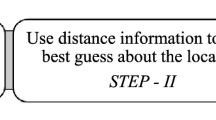Abstract
Among synchronization protocols applied in wireless sensor network, reference broadcast synchronization (RBS) is one prominent protocol achieving very high accuracy of synchronization given that the broadcasting medium is available. However, that the protocol lacks packet loss tolerance brings about degraded performance in severe conditions of wireless channel. Also, the instantaneous synchronization used in this protocol results in time discontinuity, which might cause serious faults in the distributed system. In this study, we propose a packet loss tolerance and continuous synchronization mechanism for RBS. Then we verified the result through simulations.












Similar content being viewed by others
References
Elson, J., Girod, L., & Estrin, D. (2002). Fine-grained network time synchronization using reference broadcasts. In Proceedings in Fifth Symposium on Operating Systems Design and Implementation (OSDI 2002), Vol. 36, pp. 147–163.
Mock, M., Frings, R., Nett, E., & Trikaliotis, S. (2000). Continuous clock synchronization in wireless real-time applications. In Proceedings of 19th IEEE Symposium on Reliable Distributed Systems (SRDS-00), pp. 125–133.
Sundararaman, B., Buy, U., & Kshemkalyani, A. (2005). Clock synchronization for wireless sensor networks: a survey. Ad hoc networks. Amsterdam: Elsevier.
Lamport, L. (1978). Time, clocks, and the ordering of events in a distributed system. In Proceedings of Communications of the ACM, Vol. 21, pp. 558–565.
Ryu, M., & Hong, S. (1998). Revisiting clock synchronization problems: Static and dynamic constraint transformations for correct timing enforcement. Technical Report No. SNU-EE-TR-1998-3, Seoul National University, South Korea.
Zhao, J., & Govindan, R. (2003). Understanding packet delivery performance in dense wireless sensor networks. In Proceedings of 1st International Conference on Embedded networked sensor systems, pp. 1–13.
Shin, J., Ramachandran, U., & Ammar, M. (2007). On improving the reliability of packet delivery in dense wireless sensor networks. In Proceedings of 16th International Conference on Computer Communications and Networks, pp. 718–723.
Lundelius Welch, J., & Lynch, N. (1988). A new fault-tolerant algorithm for clock synchronization. Information and Computation, 77(1), 1–36.
Acknowledgments
This research was supported by the MSIP (Ministry of Science, ICT and Future Planning), Korea, under the C-ITRC (Convergence Information Technology Research Center) (IITP-2015-H8601-15-1001) supervised by the IITP (Institute for Information and communications Technology Promotion)
Author information
Authors and Affiliations
Corresponding author
Rights and permissions
About this article
Cite this article
Do, TH., Yoo, M. Continuous Reference Broadcast Synchronization with Packet Loss Tolerance. Wireless Pers Commun 86, 1751–1763 (2016). https://doi.org/10.1007/s11277-015-3107-6
Published:
Issue Date:
DOI: https://doi.org/10.1007/s11277-015-3107-6




